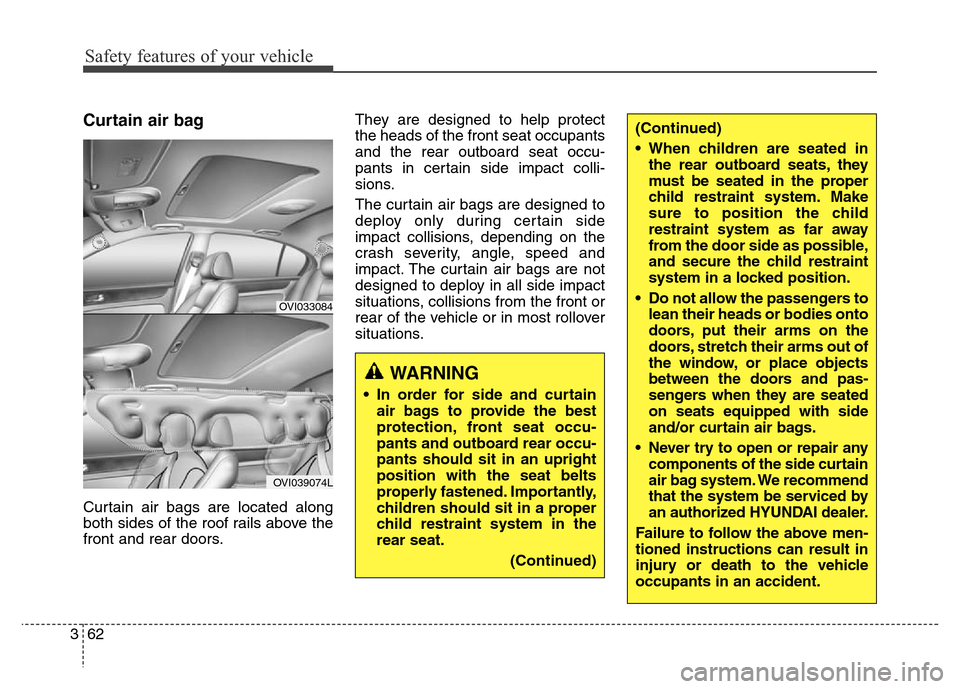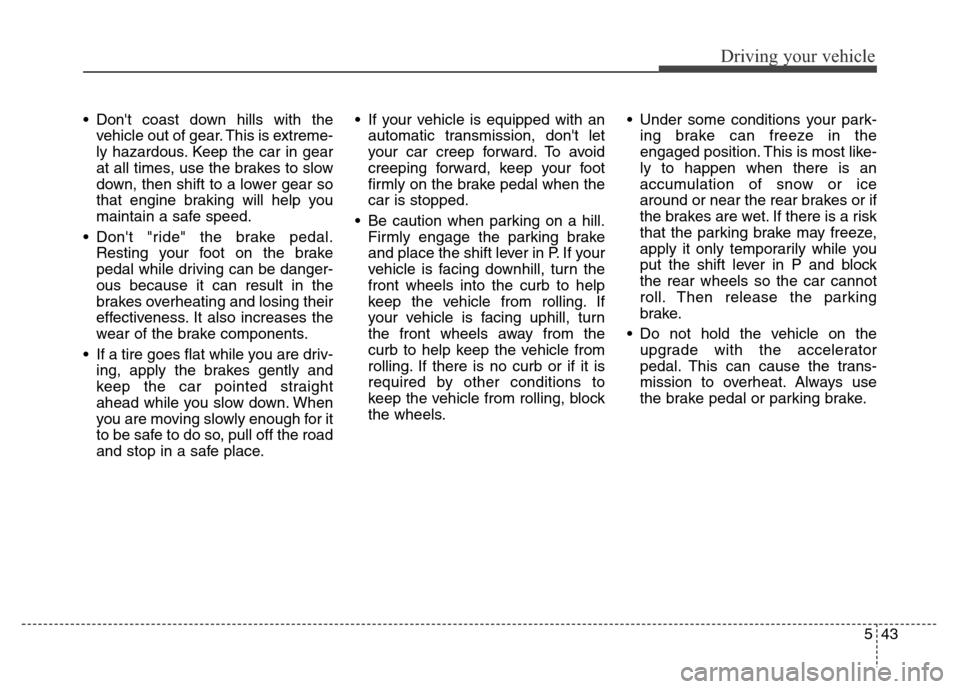2013 Hyundai Equus front head rest
[x] Cancel search: front head restPage 21 of 479

Safety features of your vehicle
2 3
Driver’s seat
(1) Seat sliding forward or back-
ward**/ Seat height and cushion
tilting adjustment
(2) Seat cushion length adjustment
(3) Seatback angle adjustment
(4) Headrest height adjustment
(5) Driver position memory system
(6) Climate control system seat*
(7) Lumbar support adjustment
Front passenger’s seat
(8) Seat sliding forward or back-
ward/ Seat height and cushion
tilting adjustment*
(9) Seatback angle adjustment
(10) Headrestheight adjustment
(11) Climate control system seat*
SEATS
OVI033001
■Type A■Type B■Type C
Page 22 of 479

33
Safety features of your vehicle
Rear seat
(12) Seat sliding forward or back-
ward adjustment with seatback
angle adjustment
(13) Climate control system seat*
(14) Armrest
(15) Leg support angle adjustment
(16) Headrest height adjustment
(17) Easy access
(18) Front passenger side walk-in
seat
(19) Rear relaxation seat system
(20) Lumber support adjustment
(21) Return switch
(22) Foot rest adjustment
(23) Passenger seat adjustment
switch*
*: if equipped
**: The height of the driver's headrest
is automatically adjusted simulta-
neously with the driver's seat slid-
ing adjustment operation.
WARNING- Loose
objects
Loose objects in the driver’s
foot area could interfere with
the operation of the foot pedals,
possibly causing an accident.
Do not place anything under the
front seats.
WARNING- Driver
responsibility for passen-
gers
Riding in a vehicle with the
seatback reclined could lead to
serious or fatal injury in an acci-
dent. If a seat is reclined during
an accident, the occupant’s
hips may slide under the lap
portion of the seat belt applying
great force to the unprotected
abdomen. Serious or fatal inter-
nal injuries could result. The
driver must advise the passen-
ger to keep the seatback in an
upright position whenever the
vehicle is in motion.
WARNING
Do not use a seat cushion that
reduces friction between the
seat and passenger. The pas-
senger's hips may slide under
the lap portion of the seat belt
during an accident or a sudden
stop. Serious or fatal internal
injuries could result because
the seat belt can't operate nor-
mally.
WARNING- Driver’s seat
• Never attempt to adjust the
seat while the vehicle is mov-
ing. This could result in loss
of control, and an accident
causing death, serious injury,
or property damage.
(Continued)
Page 26 of 479

37
Safety features of your vehicle
Headrest
The driver's and front passenger's
seats are equipped with a headrest
for the occupant's safety and com-
for t.
The headrest not only provides com-
fort for the driver and front passen-
ger, but also helps to protect the
head and neck in the event of a colli-
sion.Forward and backward adjustment
The headrest may be adjusted for-
ward or backward by pulling the
lower part of the headrest forward or
backward to the desired detent in the
direction of the arrow. Adjust the
headrest so that it properly supports
the head and neck.
OBH038075L
WARNING
• For maximum effectiveness in
case of an accident, the head-
rest should be adjusted so the
middle of the headrest is at
the same height as the center
of gravity of an occupant's
head. Generally, the center of
gravity of most people's head
is similar with the height of
the top of their eyes. Also,
adjust the headrest as close
to your head as possible. For
this reason, the use of a cush-
ion that holds the body away
from the seatback is not rec-
ommended.
• Do not operate the vehicle
with the headrests removed
as severe injury to the occu-
pants may occur in the event
of an accident. Headrests may
provide protection against
neck injuries when properly
adjusted.
• Do not adjust the headrest
position of the driver's seat
while the vehicle is in motion.
OVI039007
Page 27 of 479

Safety features of your vehicle
8 3
Adjusting the headrest up and down
Push the control switch up to raise or
down to lower the headrest. Release
the switch once the headrest reach-
es the desired position.Removal
To remove the headrest:
1. Recline the seatback (2) with the
recliner control switch (1).
2. Raise it as far as it can go by
pulling the switch up (3) then pull
the headrest up (4).
OVI039010OVI033101N
WARNING
NEVER allow anyone to ride in a
seat with the headrest removed.
OYFH034205
CAUTION
If you recline the seatback
towards the front with the head-
rest and seat cushion raised,
the headrest may come in con-
tact with the sunvisor or other
parts of the vehicle.
Page 29 of 479

Safety features of your vehicle
10 3
Electronic active headrest
The electronic active headrest is
designed to trigger the headrest for-
ward and upward when impact sen-
sor detects a rear impact. This helps
to prevent the driver's and front pas-
senger’s heads from moving back-
ward and thus helps minimize neck
injuries.
Seat warmer (if equipped)
The seat warmer is provided to warm
the front seats during cold weather.
While the engine is running, push
either of the switches to warm the
driver's seat or the front passenger's
seat.
During mild weather or under condi-
tions where the operation of the seat
warmer is not needed, keep the
switches in the OFF position.
• Each time you push the switch, the
temperature setting of the seat
changes as follows :• When pressing the switch for more
than 1.5 seconds with the seat
warmer operating, the seat warmer
will turn OFF.
• The seat warmer defaults to the
OFF position whenever the engine
start/stop button is turned to the
ON position.
✽NOTICE
With the seat warmer switch in the
ON position, the heating system in
the seat turns off or on automatically
depending on the seat temperature.OBH038069
CAUTION
The active headrest is a safety
device to reduce injuries from a
rear impact. Do not hit or pull
the headrest intentionally.
OVI033011
OFF→HIGH( )→MIDDLE( )→LOW( )
→
Page 81 of 479

Safety features of your vehicle
62 3
Curtain air bag
Curtain air bags are located along
both sides of the roof rails above the
front and rear doors.They are designed to help protect
the heads of the front seat occupants
and the rear outboard seat occu-
pants in certain side impact colli-
sions.
The curtain air bags are designed to
deploy only during certain side
impact collisions, depending on the
crash severity, angle, speed and
impact. The curtain air bags are not
designed to deploy in all side impact
situations, collisions from the front or
rear of the vehicle or in most rollover
situations.
WARNING
• In order for side and curtain
air bags to provide the best
protection, front seat occu-
pants and outboard rear occu-
pants should sit in an upright
position with the seat belts
properly fastened. Importantly,
children should sit in a proper
child restraint system in the
rear seat.
(Continued)
OVI033084
OVI039074L
(Continued)
• When children are seated in
the rear outboard seats, they
must be seated in the proper
child restraint system. Make
sure to position the child
restraint system as far away
from the door side as possible,
and secure the child restraint
system in a locked position.
• Do not allow the passengers to
lean their heads or bodies onto
doors, put their arms on the
doors, stretch their arms out of
the window, or place objects
between the doors and pas-
sengers when they are seated
on seats equipped with side
and/or curtain air bags.
• Never try to open or repair any
components of the side curtain
air bag system. We recommend
that the system be serviced by
an authorized HYUNDAI dealer.
Failure to follow the above men-
tioned instructions can result in
injury or death to the vehicle
occupants in an accident.
Page 208 of 479

4119
Features of your vehicle
AFLS (Adaptive Front Lighting
System) (if equipped)
Adaptive front lighting system uses
the steering angle and vehicle speed,
to keep your field of vision wide by
swiveling and leveling the headlamp.
Change the switch to the AUTO posi-
tion when the engine is running. The
adaptive front lighting system will
operate when the headlamp is ON.
To turn off the AFLS, change the
switch to other positions. After turn-
ing the AFLS off, headlamp swiveling
no longer occurs, but leveling oper-
ates continuously.If the AFLS malfunction indicator
comes on, the AFLS is not working
properly. Drive to the nearest safe
location and restart the engine. If the
indicator continuously remains on,
we recommend that the system be
checked by an authorized HYUNDAI
dealer.
Position lamp position ( )
When the light switch is in the posi-
tion lamp position, the position,
license and instrument panel lights
will turn ON.OVI043091
OVIDDI2916/OVI043425
■Type A■Type B
ODM042245
Page 300 of 479

543
Driving your vehicle
• Don't coast down hills with the
vehicle out of gear. This is extreme-
ly hazardous. Keep the car in gear
at all times, use the brakes to slow
down, then shift to a lower gear so
that engine braking will help you
maintain a safe speed.
• Don't "ride" the brake pedal.
Resting your foot on the brake
pedal while driving can be danger-
ous because it can result in the
brakes overheating and losing their
effectiveness. It also increases the
wear of the brake components.
• If a tire goes flat while you are driv-
ing, apply the brakes gently and
keep the car pointed straight
ahead while you slow down. When
you are moving slowly enough for it
to be safe to do so, pull off the road
and stop in a safe place.• If your vehicle is equipped with an
automatic transmission, don't let
your car creep forward. To avoid
creeping forward, keep your foot
firmly on the brake pedal when the
car is stopped.
• Be caution when parking on a hill.
Firmly engage the parking brake
and place the shift lever in P. If your
vehicle is facing downhill, turn the
front wheels into the curb to help
keep the vehicle from rolling. If
your vehicle is facing uphill, turn
the front wheels away from the
curb to help keep the vehicle from
rolling. If there is no curb or if it is
required by other conditions to
keep the vehicle from rolling, block
the wheels.• Under some conditions your park-
ing brake can freeze in the
engaged position. This is most like-
ly to happen when there is an
accumulation of snow or ice
around or near the rear brakes or if
the brakes are wet. If there is a risk
that the parking brake may freeze,
apply it only temporarily while you
put the shift lever in P and block
the rear wheels so the car cannot
roll. Then release the parking
brake.
• Do not hold the vehicle on the
upgrade with the accelerator
pedal. This can cause the trans-
mission to overheat. Always use
the brake pedal or parking brake.